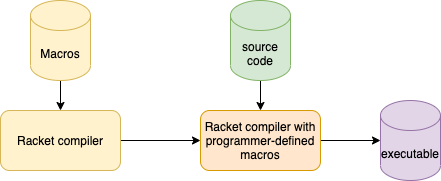Racket Switch Macro
Introduction
Deconstruction of switch macro in Racket.
switch macro discussion on Stack Overflow
Prerequisites
The Racket compiler allows programmers to define macros which get inserted into the compilation phase.

Racket macros are written in Racket and operate on syntax objects.
[aside: The Racket compiler manipulates syntax objects. The Lisp (a precursor to Racket) compiler manipulates lists.]
STX usually denotes a syntax object.
I use ___ for elision, avoiding ..., since that is used as syntax in Racket macros.
#' creates a syntax object from a Racket expression.
Macros are functions that execute at compile-time. Macros manipulate the original source code and expand into final source-code.
Top Layer
#lang racket
;; see https://stackoverflow.com/questions/32793972/racket-switch-statement-macro
(require (for-syntax syntax/parse))
(define-syntax (switch stx)
(define (transform-clause cl)
___
(define (transform-clauses cls)
___
(syntax-case stx ()
___
(define x 5)
(define (test1)
;; uses builtin 'case'
(case x
((3) (displayln "x is 3"))
((4) (displayln "x is 4"))
((5) (displayln "x is 5"))
(else (displayln "none of the above"))))
(define (test2)
;; uses macro 'switch'
(switch x
[3 (displayln "sw x is 3")]
[4 (displayln "sw x is 4")]
[5 (displayln "sw x is 5")]
[default (displayln "sw none of the above")]))
(test1)
(test2)
The require is used to set up the compiler for macro processing [don’t worry about what this means for now.]
The macro is called switch and is defined in the define-syntax form.
The macro uses 2 auxiliary functions, transform-clause and transform-clauses.
The main body of the macro is in the (syntax-case stx () ___) clause. [For now, don’t worry about the meaning of () as the second part of the syntax-case].
Test2 is the test of the macro. Test1 is the equivalent code using the builtin case form.
Layer 1
(syntax-case stx ()
((_ x clause ...)
(with-syntax (((case-clause ...) (transform-clauses #'(clause ...))))
#'(case x case-clause ...)))))
The _ is a short-hand for the macro name, in this case switch.
Looking at test2, the compiler (macro expander) sees a switch expression:
(switch ___)
and binds the three variables:
x <= x
clause <=
[3 (displayln "sw x is 3")]
[4 (displayln "sw x is 4")]
[5 (displayln "sw x is 5")]
[default (displayln "sw none of the above")]
... <=
This says that when the compiler matches an expression starting with switch, it will bind the second item (of the expression) to x, the third item to clause and lump all of the rest of the items into ....
x and clause and ... can only be used in syntax manipulation expressions.
clause is used in the #'(clause ...) expression which forms the argument to the auxilliary function transform-clauses.
with-syntax does more (recursive) pattern-matching. The result of transform-clausesis matched and bound to case-clause.
The final #'(case x case-clause) expression uses the two bound syntax variables, x and case-clause and returns a syntax expression that forms a case expression.
That returned expresssion is fed to the macro-expander part of the compiler which feeds into the rest of the downstream compilation. Hence, whereever (switch ___ ___ ) appears in the code, it will be replaced by the expanded macro (a case expression, in this instance).
Layer 2
(define (transform-clauses cls)
(syntax-case cls ()
((cl)
(with-syntax ((case-clause (transform-clause #'cl)))
#'(case-clause)))
((cl rest ...)
(with-syntax ((case-clause (transform-clause #'cl))
((case-rest ...) (transform-clauses #'(rest ...))))
#'(case-clause case-rest ...)))))
The auxiliary function transform-clauses takes one parameter, named cls, and performs a syntax-based pattern-match.
Cls is of type syntax.
The first clause (cls)matches the degenerate case of a single clause. It calls transform-clause and returns that syntactic value. To perform the return, it pattern-matches the result of transform-clause, binds the match to case-clause, then returns case-clause as a #' syntax object.
The other clause (cl rest ...) matches the case of multiple clauses, binding the matches into variables cl, rest and ....
cl <=
[3 (displayln "sw x is 3")]
rest <=
[4 (displayln "sw x is 4")]
[5 (displayln "sw x is 5")]
[default (displayln "sw none of the above")]))
The macro expansion is performed recursively until the degenerate case ([default ___]) is reached.
cl <=
[4 (displayln "sw x is 4")]
rest <=
[5 (displayln "sw x is 5")]
[default (displayln "sw none of the above")]))
cl <=
[5 (displayln "sw x is 5")]
rest <=
[default (displayln "sw none of the above")]))
cl <=
[default (displayln "sw none of the above")]))
rest <=
Layer 3
(define (transform-clause cl)
(syntax-case cl (default)
((default expr) #'(else expr))
((val ... expr) #'((val ...) expr))))
The auxiliary function transform-clause converts one clause into its final form, e.g.
[3 (displayln "sw x is 3")]
gets bound to variables
val <= 3
... <=
expr <= (displayln "sw x is 3")
and is expanded into
#'((3) (displayln "sw x is 3"))
while the default clause is bound to variable:
expr <= (displayln "sw none of the above")
and expands into
#'(else (displayln "sw none of the above"))
Complete Version
#lang racket
;; see https://stackoverflow.com/questions/32793972/racket-switch-statement-macro
(require (for-syntax syntax/parse))
(define-syntax (switch stx)
(define (transform-clause cl)
(syntax-case cl (default)
((default expr) #'(else expr))
((val ... expr) #'((val ...) expr))))
(define (transform-clauses cls)
(syntax-case cls ()
((cl)
(with-syntax ((case-clause (transform-clause #'cl)))
#'(case-clause)))
((cl rest ...)
(with-syntax ((case-clause (transform-clause #'cl))
((case-rest ...) (transform-clauses #'(rest ...))))
#'(case-clause case-rest ...)))))
(syntax-case stx ()
((_ x clause ...)
(with-syntax (((case-clause ...) (transform-clauses #'(clause ...))))
#'(case x case-clause ...)))))
(define x 5)
(define (test1)
;; uses builtin 'case'
(case x
((3) (displayln "x is 3"))
((4) (displayln "x is 4"))
((5) (displayln "x is 5"))
(else (displayln "none of the above"))))
(define (test2)
;; uses macro 'switch'
(switch x
[3 (displayln "sw x is 3")]
[4 (displayln "sw x is 4")]
[5 (displayln "sw x is 5")]
[default (displayln "sw none of the above")]))
(test1)
(test2)